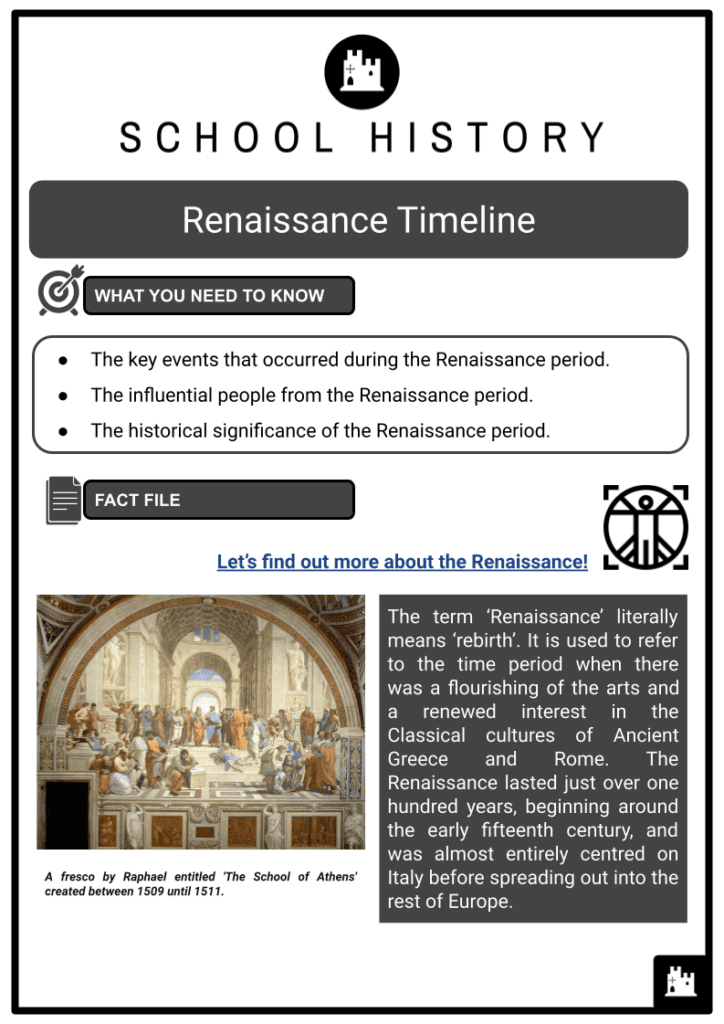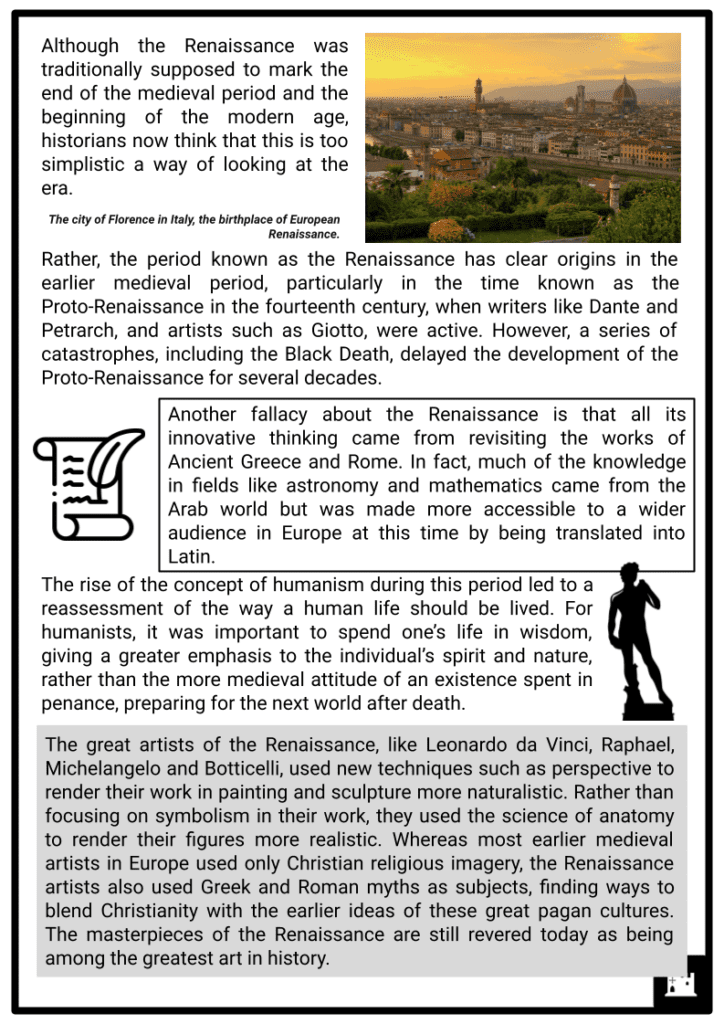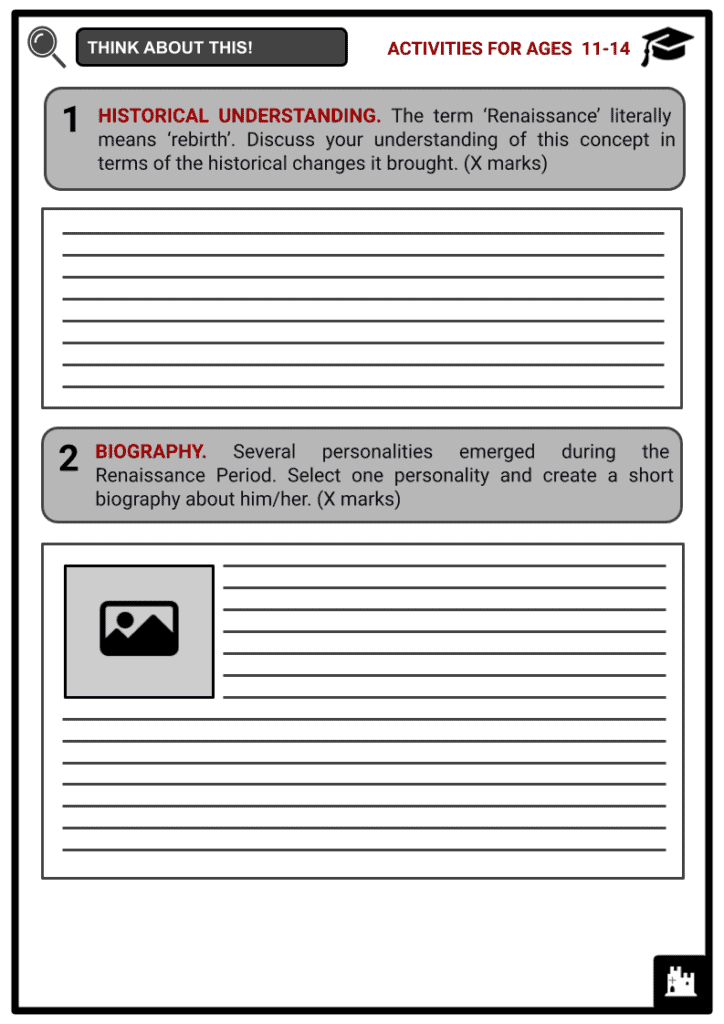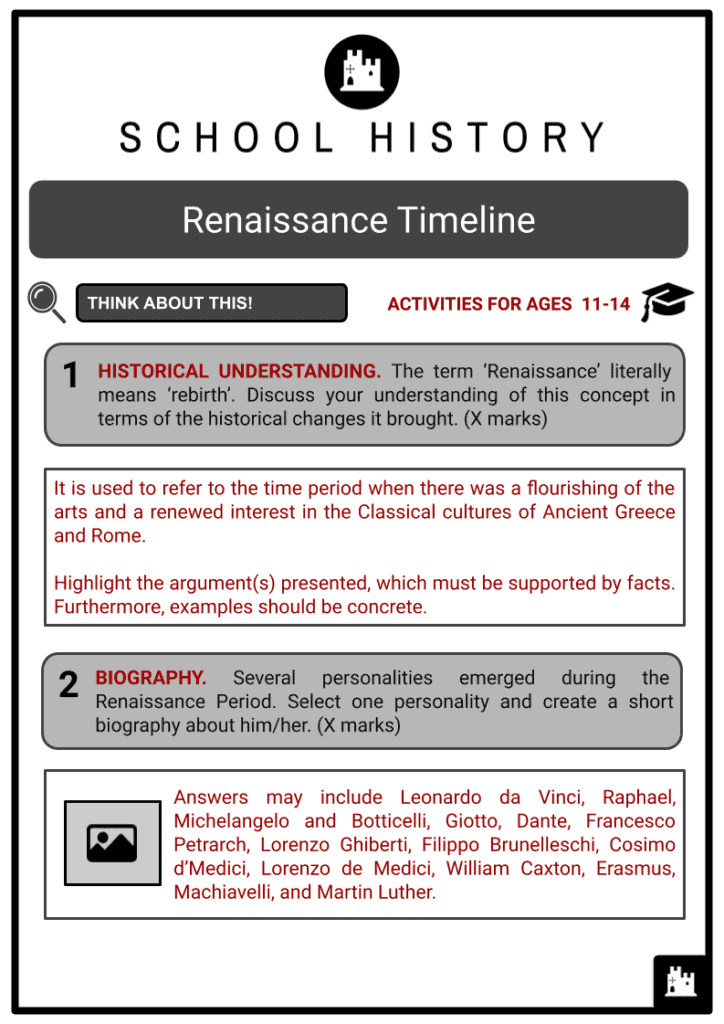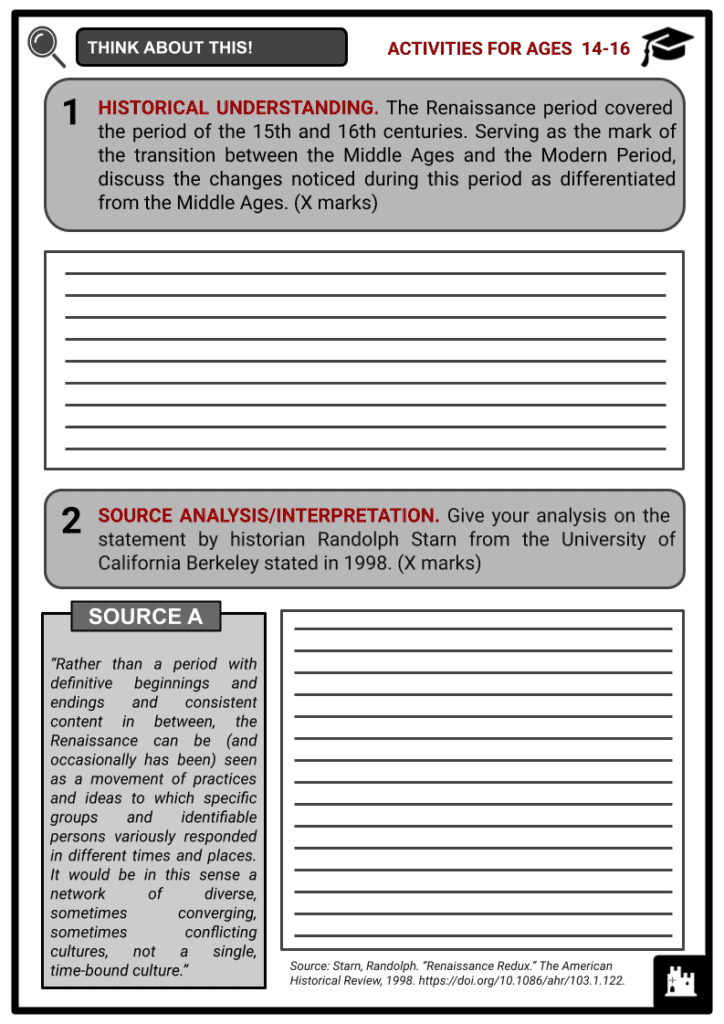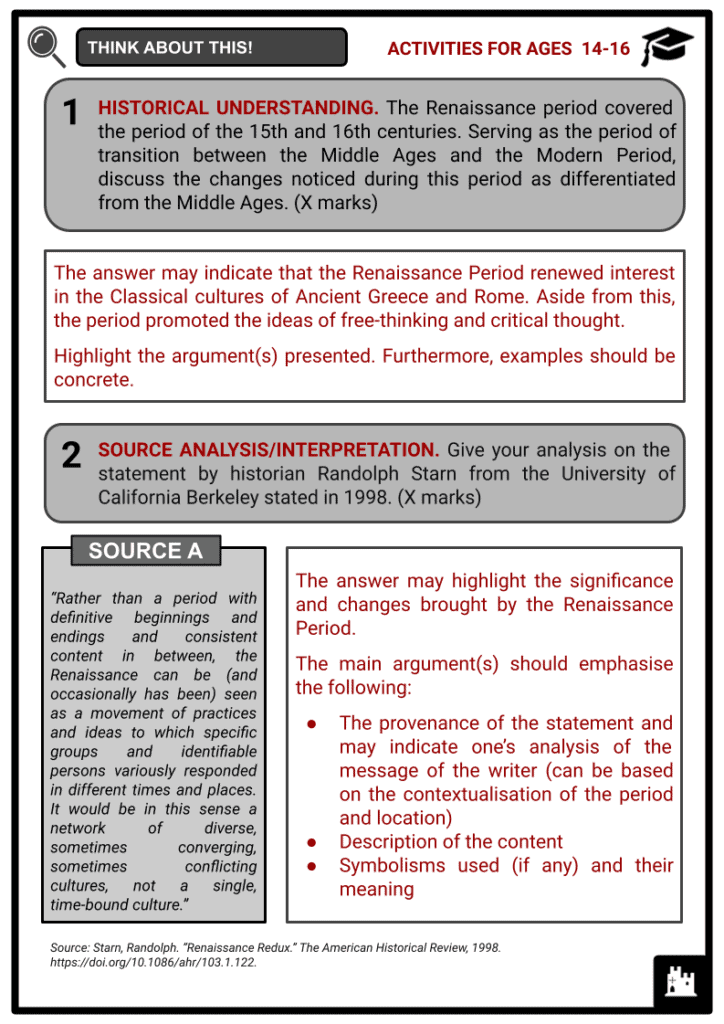Download Renaissance Timeline Worksheets
Do you want to save dozens of hours in time? Get your evenings and weekends back? Be able to teach about Renaissance Timeline to your students?
Our worksheet bundle includes a fact file and printable worksheets and student activities. Perfect for both the classroom and homeschooling!
Table of Contents
Add a header to begin generating the table of contents
Summary
- The key events that occurred during the Renaissance period.
- The influential people from the Renaissance period.
- The historical significance of the Renaissance period.
Key Facts And Information
Let’s know more about the Renaissance Timeline!
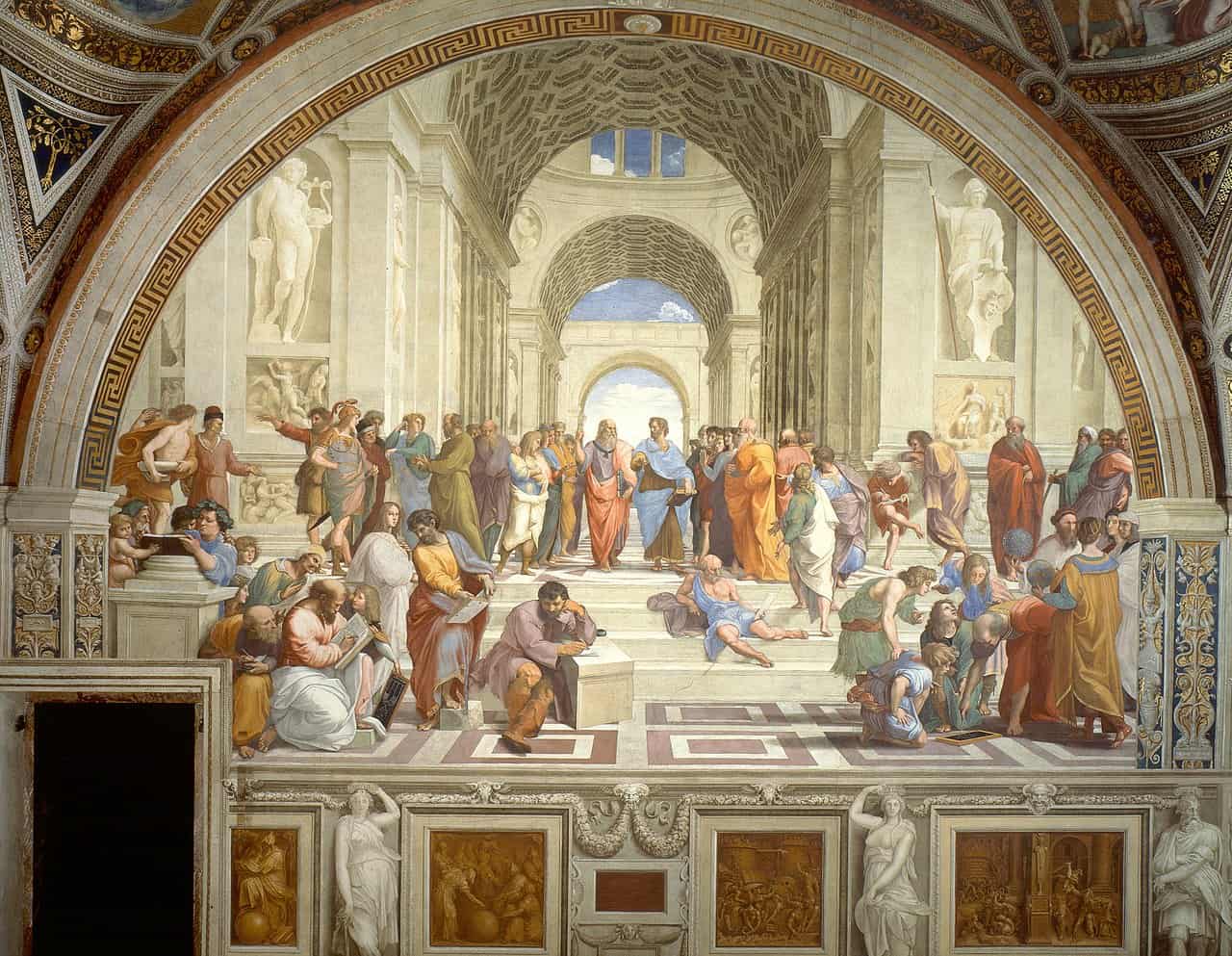
- The term ‘Renaissance’ literally means ‘rebirth’. It is used to refer to the time period when there was a flourishing of the arts and a renewed interest in the Classical cultures of Ancient Greece and Rome. The Renaissance lasted just over one hundred years, beginning around the early fifteenth century, and was almost entirely centred on Italy before spreading out into the rest of Europe.
- Although the Renaissance was traditionally supposed to mark the end of the medieval period and the beginning of the modern age, historians now think that this is too simplistic a way of looking at the era.
- Rather, the period known as the Renaissance has clear origins in the earlier medieval period, particularly in the time known as the Proto-Renaissance in the fourteenth century, when writers like Dante and Petrarch, and artists such as Giotto, were active. However, a series of catastrophes, including the Black Death, delayed the development of the Proto-Renaissance for several decades.
- Another fallacy about the Renaissance is that all its innovative thinking came from revisiting the works of Ancient Greece and Rome. In fact, much of the knowledge in fields like astronomy and mathematics came from the Arab world but was made more accessible to a wider audience in Europe at this time by being translated into Latin.
- The rise of the concept of humanism during this period led to a reassessment of the way a human life should be lived. For humanists, it was important to spend one’s life in wisdom, giving a greater emphasis to the individual’s spirit and nature, rather than the more medieval attitude of an existence spent in penance, preparing for the next world after death.
- The great artists of the Renaissance, like Leonardo da Vinci, Raphael, Michelangelo and Botticelli, used new techniques such as perspective to render their work in painting and sculpture more naturalistic. Rather than focusing on symbolism in their work, they used the science of anatomy to render their figures more realistic. Whereas most earlier medieval artists in Europe used only Christian religious imagery, the Renaissance artists also used Greek and Roman myths as subjects, finding ways to blend Christianity with the earlier ideas of these great pagan cultures. The masterpieces of the Renaissance are still revered today as being among the greatest art in history.
Key Events
1305
- The artist Giotto completes work on his masterpiece, the Scrovegni Chapel interior in Padua. Giotto’s natural style was a departure from the Gothic style of other medieval artists and the forerunner of the artists of the Renaissance.
1320
- Dante completes his Divine Comedy in Italian, written over about 12 years, featuring the Roman poet Virgil as the author’s guide through the realms of Hell and Purgatory. Dante was part of the Proto-Renaissance, the first flowering of interest in humanism and classical thought that was cut short by the disastrous effects of plague, famine and a cooling climate in Europe.
1341
- The humanist Petrarch is made poet laureate in Rome. Petrarch rediscovers the letters of the Roman statesman Cicero and believes that ethical wisdom can be obtained by studying ancient writers. He is credited with reviving the interest in the Classics that characterised the Renaissance.
1401
- Young goldsmith Lorenzo Ghiberti is commissioned to create doors for the Baptistry of San Giovanni in Florence. The resulting carvings are of such high artistic quality that the east doors are later dubbed the ‘Gates of Paradise’ by Michelangelo.
1417
- The Western Schism ends, a period in which the Catholic Church has been split by rival candidates claiming to be the true pope. With the popes based in Rome now confirmed as the official line, the city once again becomes the focal point for building programmes and art commissions for beautifying religious buildings, bringing many new artists into the spotlight.
1419
- Filippo Brunelleschi designs the Duomo for the cathedral in Florence, the first dome of this size constructed since the ancient period. Brunelleschi is also credited with describing the artistic concept of linear perspective, in which objects in the art are drawn as they are seen in life by the human eye, with more distant objects being smaller.
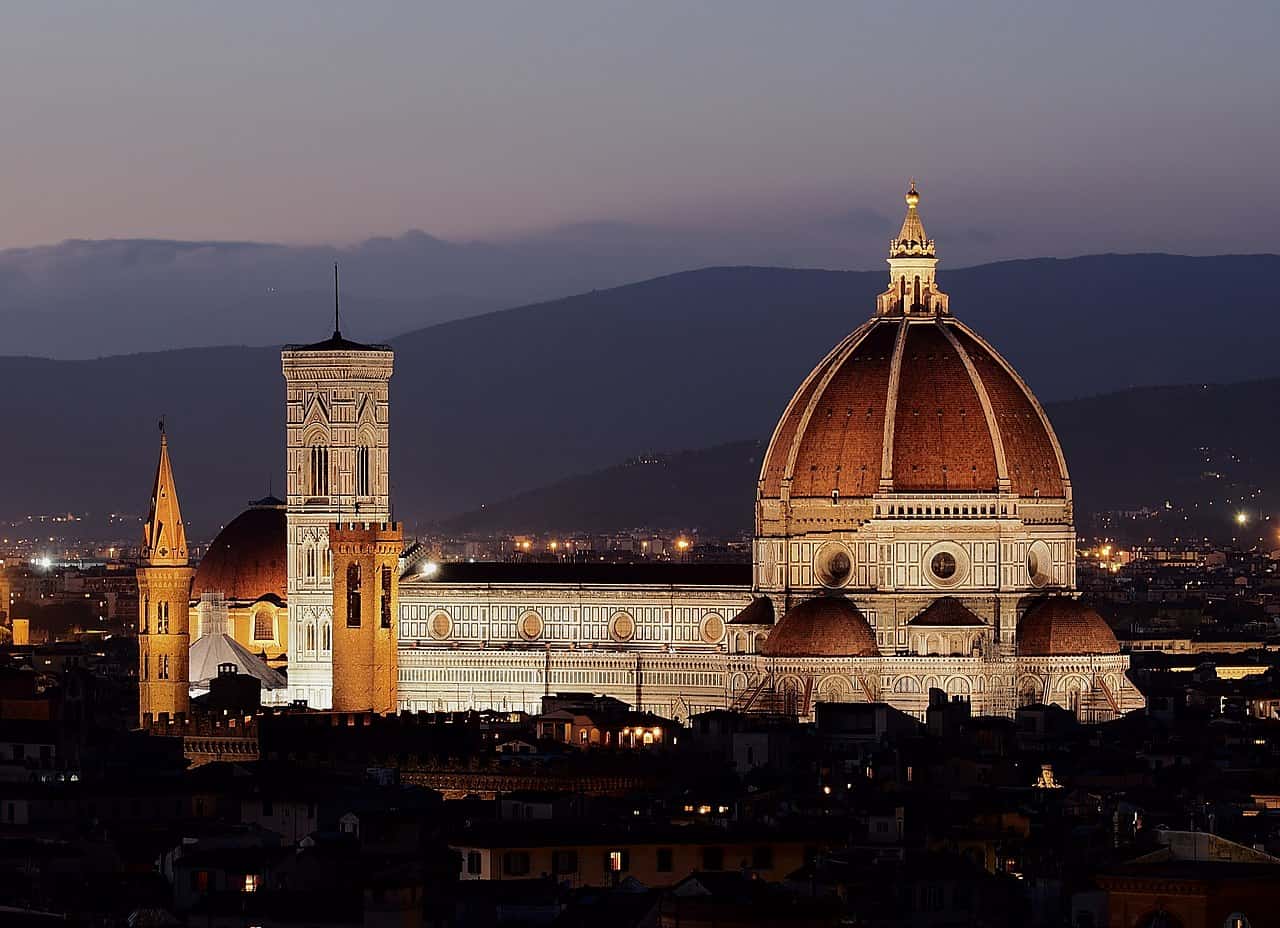
1420s
- Pope Martin V, the first pope elected since the end of the Western Schism, arrives in Rome and begins an extensive rebuilding programme using the talents of many of the leading artists of the Renaissance.
1434
- Cosimo de’ Medici becomes ruler of Florence. The flourishing of the Renaissance in Florence was enabled by the financial support of rich families like the Medici. Investing their wealth in the arts was a way of displaying their power around the city.
1447
- Nicholas V is appointed Pope. He is enthusiastic about the arts and new ideas in architecture and uses his position to instigate many construction projects and art commissions to glorify Rome and make it an important Renaissance city.
1452
- Leonardo da Vinci is born in Vinci near Florence. As a teenager he is apprenticed in an artist’s studio in Florence; he would go on to become one of the leading figures of the Renaissance and one of the most remarkable intellects in history.
1453
- The fall of Constantinople to the Ottoman Empire sends eastern scholars fleeing to Italy, bringing their books and a Greek tradition of learning with them.
1455
- The Gutenberg Bible is published, one of the first books in Europe to be printed using movable metal type on a printing press. The mass production of books would have an almost incalculable effect on the spread of knowledge.
1469
- Lorenzo de Medici, otherwise known as Lorenzo the Magnificent, becomes the ruler of Florence. His generous patronage of the arts, which included funding the artists Michelangelo and Botticelli, further cements Florence as the centre of the Renaissance.
1473
- William Caxton prints the first book in English, The Recuyell of the Historyes of Troye, on a printing press he learned to use in Belgium. Three years later he ships a printing press back to England, bringing the revolution of printed books to his home country.
1486
- Botticelli paints The Birth of Venus. Its depiction of a scene from Classical mythology is unusual at the time when European art commonly features Christian religious imagery. The piece is one of the most famous artworks produced in the Renaissance.
The 1490s
- During this decade, the High Renaissance is said to begin in Italy. This term is used to describe the period that is widely regarded as the height of artistic achievement during the Renaissance when artists such as Leonardo da Vinci, Raphael, Titian, and Michelangelo are all producing masterpieces of painting and sculpture.
1498
- Leonardo da Vinci completes his painting The Last Supper on the refectory wall of the Santa Maria delle Grazie convent in Milan. The piece’s use of perspective, a key technique of the Renaissance artists, is intended to show the room in the painting as an extension of the real room in which it was painted.
1499
- King Louis XII of France conquers the Duchy of Milan during the French-Italian Wars. As Milan has been one of the leading centres of the Renaissance under the wealthy Sforza family, its occupation by the French leads to the more rapid spread of Renaissance ideas back into France.
1504
- Michelangelo completes David, one of the most famous pieces of Renaissance sculpture. Although the piece depicts a Biblical hero, it is also a personification of Florence, a city under threat from the powerful rivals that surround it. The style of the statue echoes the heroic nudes frequently found in Greek and Roman art.
1506
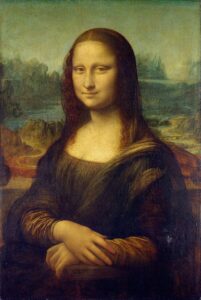
- Leonardo da Vinci completes Mona Lisa. The painting of an Italian noblewoman becomes an icon of the Renaissance and is still one of the most well-known – and valuable – artworks of all time. Its alternative title, La Gioconda or ‘Happy One’, refers to the subject’s famous smile.
1508-1512
- By this time, Michelangelo paints the ceiling of the Sistine Chapel in the Vatican. Despite the artist himself preferring the medium of sculpture, the Biblical scenes he paints in the Sistine Chapel become a celebrated Renaissance masterpiece.
1509
- The humanist scholar Erasmus writes In Praise of Folly, a satirical essay attacking the superstitions of the Catholic church. It is considered one of the classic written works of the Renaissance due to its extensive use of Classical allusions. As well as its importance in the Renaissance, Erasmus’ work was also a key text in the Protestant Reformation of the 16th century.
1511
- Raphael paints The School of Athens, one of a group of fresco paintings in the Vatican depicting different branches of knowledge. The School of Athens shows contemporary figures portrayed as great philosophers and features a wonderful example of the Renaissance perspective technique.
1513
- Machiavelli completes The Prince, a work of early modern philosophy advising rulers on how to win and keep power, by acknowledging that the rules for ordinary people do not apply to them. It was one of the most famous – or infamous – written works of the Renaissance, notable also for being written in Italian, not Latin.
1516
- Erasmus produces a Latin translation of the New Testament from the Greek, with the intention of rendering the text as close to the original as possible, as well as making the book more accessible to a wider readership. Also, Sir Thomas More published Utopia, a socio-political satire that uses the Renaissance tradition of humanist thinking to consider what is needed to create an ideal society.
1517
- The Reformation officially begins when Martin Luther produces his 95 Theses, criticising some of the practices of the Catholic church. The leading figures of the Reformation are heavily influenced by the humanist thinking of the Renaissance.
1527
- The Sack of Rome by the Holy Roman Emperor Charles V causes devastation to the city and has repercussions throughout Italy. The weakening of the power bases of Italy’s leading families and the poor social conditions in the cities has a detrimental effect on the arts, and this event is therefore said to mark the end of the Renaissance.
Summary
- The great minds of the Renaissance learned to look at the world in a new way, while the innovation of printed books enabled this new way of thinking to spread rapidly across the continent of Europe. Literacy began to rise, with the ability to read the Bible oneself seen as important in gaining an understanding of the word of God.
- Art was seen as a route to knowledge, as a way of examining humankind’s place in creation and its relationship with God, and its importance increased hugely. Wealthy families like the Medici of Florence, as well as kings and popes, vied to have the best artists of the time working for them, to give them a legacy in the form of paintings, sculpture and architecture that they hoped would last for the ages.
- The Renaissance popularised a questioning of the status quo, especially of the Church, which sowed the seeds of the religious Reformation. It promoted the ideas of free-thinking and critical thought. The situation created during the Renaissance was that knowledge and learning were taken out of the exclusive hands of the clergy and placed within the reach of secular rulers and even ordinary people. This led to a shift in the balance of power in Europe, with the influence of the Pope diminishing. Access to the texts of the Ancient Romans led monarchs and nobles to question the very nature of authority, while the new printing presses enabled the first widespread use of propaganda to influence the thinking of the masses.
- The world was entering the modern age, and it would never be the same again.

